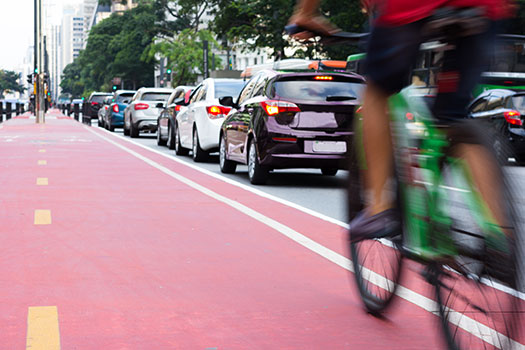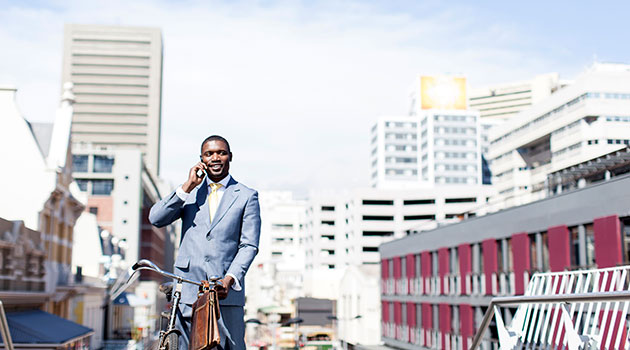With April’s showers left behind and June’s hot sticky days yet to arrive, May is the perfect time to get outside, breathe the fresh air, and enjoy the fair weather—so it’s no wonder it’s been designated National Bike Month.
May 18 marked National Bike to Work Day. This year, more Americans than ever had reason to celebrate.
Bicycle commuting rates are on the rise in America. They jumped up by 62% between 2005 and 2013—and that’s just on average.
Designated “bike-friendly” communities have seen the number of cycling commuters skyrocket by an average of 102% in the same time period. Some cities make even that number look small. (Portland, Oregon led the bike-friendly pack, with a cycling growth spurt of 408% between 2005 and 2013.)
And the trend holds even when the ride is simply for pleasure. Last spring, 66.1 million people said they’d taken a two-wheeled ride in the past 12 months. That’s compared to 51 million people five years earlier.
But keeping pace with the number of rides is the number of roadway fatalities—cycling-related deaths have also increased. They reached 840 in 2016, a 1.3% jump from the previous year and the highest total since 1991.
A pedaled commute holds allure: cycling is cheap, easy, and effective, plus a great excuse for exercise.
And with carbon emissions on the rise and the number of license-holding Americans on the decline, many more will likely take to the streets atop bicycle seats.
But are the roads safe enough to handle that influx? And will the self-driving cars of the future be better at keeping cyclists alive?
Right Before Your Eyes

Distracted driving is a huge problem on the road. But even when those behind the wheel are paying perfect attention, they can threaten bikers.
Participants in a recent study demonstrated as much. The group was shown a series of pictures taken from a driver’s point of view. Half of the pictures included taxis while half included motorcycles.
When the participants were asked to explain how they’d react to certain roadway scenarios, they were twice as likely to notice the taxi as the bike. Sixty-five percent failed to see the motorcycle at all.
The phenomena is called “inattentive blindness.” It’s responsible for a number of deadly roadway incidents, called "looked-but-failed-to-see crashes," involving both motorcycles and bikes.
The issue, according to the study’s authors, is that the brain has a lot to process while driving. To help preserve cognitive resources, the mind streamlines its information intake. Motorcycles, bikes, and other objects not registering as an immediate “threat” to the car often get overlooked. So, a driver may “see” a cyclist, but not register that there’s someone actually there.
And it seems engineers may have programmed the same issue directly into autonomous cars.
Also tasked with taking in a ton of data to dictate their driving, many of the vehicles include software to give them some amount of discretion on what to react to on the road—or whether to react at all.
The systems are intended to give the computers some processing breathing room and prevent the cars from overreacting to debris on the road. But such a program was recently ruled responsible for the March death of Arizona resident Elaine Herzberg, the first pedestrian to perish at the hands of self-driving technology.
Reports show the autonomous car “saw” the woman but, exercising its freedom of choice, failed to react to her. Still, biking advocates are holding out hope that drivers, both human and computer, can be made to see the road differently.
Layers of Protection
To avoid becoming a victim of inattentive blindness, many cyclists prefer to wear eye-catching clothing. But bright neon patterns on biking apparel is only helpful when worn in the right way.
Dayglow jackets and tops were just as easy for drivers to ignore as regular-colored clothing, according to a study conducted at Clemson University.
The problem? Biking requires very little movement of the torso. Even the brightest highlighter tint washes into the background of a mind processing at full capacity.
Bright neon patterns on biking apparel is only helpful when worn in the right way.
But it’s not all bad news for bikers. The research found electric-hued shorts, pants, and leggings actually helped jog drivers out of their highway hypnosis. The constant up-and-down movement caused by rapid pedaling made the leggings—and the bikers wearing them—stand out more vividly.
Separate studies have found similar results concerning bike tail lights. A consistent red glow would eventually blend in, but a pulsating light caught more drivers’ attentions.
Optical Illusions
The tricks may be helpful to combat glassy human eyes. But whether they’ll make a difference for a vehicle programed to look-but-fail-to-see remains to be seen.
Still, the Washington, D.C.-based cycling advocacy group, the League of American Bicyclists, doesn’t want to wait to find out.
In the wake of Herzberg’s death, the group launched a letter-writing campaign to demand Congress include a “vision test” for autonomous cars in any legislation it passes to set regulations for the vehicles.
The League was also one of the signatories on a letter pleading the Senate to rethink its AV START Act, the bill that would essentially legalize self-driving cars. The late-January bid was effective so far in getting several key senators to reconsider the idea—and hold up legislative progress in the process.
But with the technology manifesting at prolific rates, Congress will have to step in eventually. The only thing more dangerous than a vision-impaired autonomous car may be a regulation-free self-driving vehicle.
If autonomous cars are truly meant to be safer than humans, they’ll have to be less selective about what—or who—they see.
